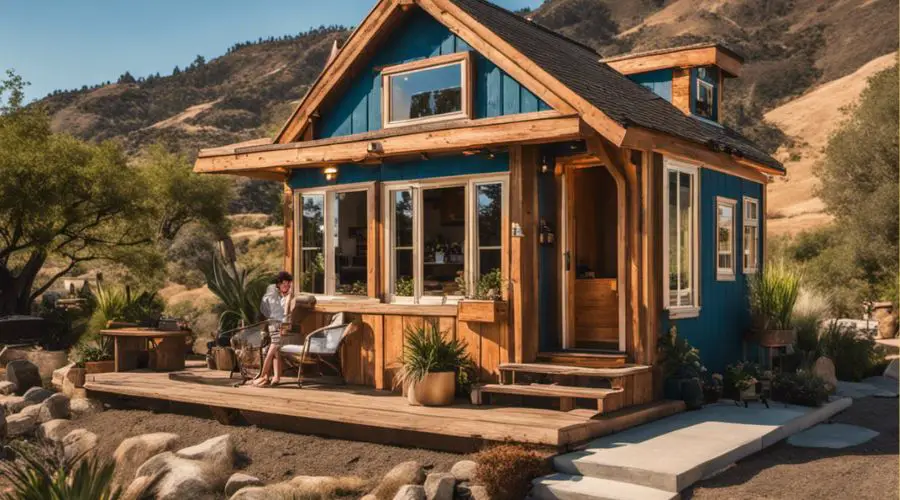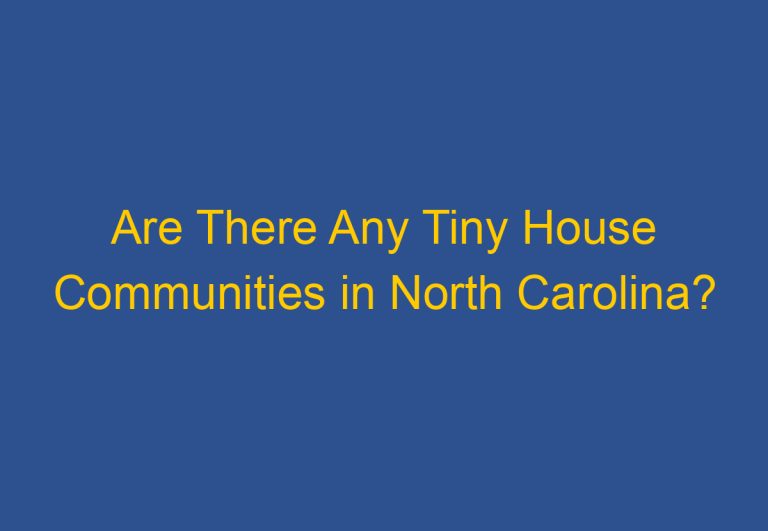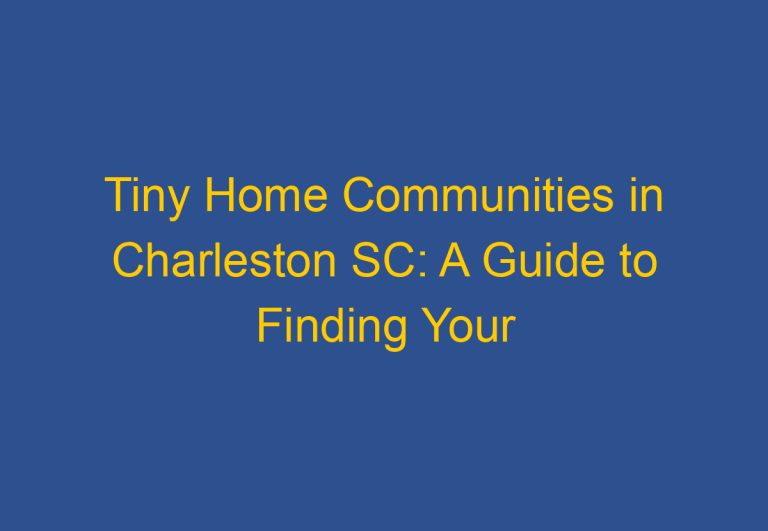Tiny Home Communities in California: A Comprehensive Guide

Tiny home communities have increasingly gained popularity in California, where the high cost of living has pushed many to seek alternative housing options.
These communities offer a unique lifestyle that promotes minimalism, sustainability, and community living.
Whether you’re looking to downsize, reduce your carbon footprint, or simply live a simpler life, there’s a tiny home community in California that could be the perfect fit for you.
One of the advantages of living in a tiny home community is the sense of community and support that comes with it.
Residents often share resources and work together to maintain the community, creating a strong sense of belonging.
Additionally, tiny homes are often more affordable and eco-friendly than traditional homes, making them an attractive option for those looking for a more sustainable and cost-effective lifestyle.
With a variety of communities located throughout the state, there’s a tiny home community in California for every taste and budget.
Tiny Home Communities
Tiny home communities have become increasingly popular in California over the past few years. These communities are designed to provide affordable housing options for people who want to live a minimalist lifestyle.
They are also ideal for people who want to reduce their carbon footprint and live a more sustainable life.
A tiny home community is a group of tiny homes that are built close together. These homes are typically between 100 and 400 square feet and can be built on trailers, RVs, or skoolies. They often have a sleeping loft, a small kitchen, and a bathroom.
One of the main benefits of living in a tiny home community is the sense of community that it provides.
People who live in these communities often share common values and interests. They also tend to be more environmentally conscious and are committed to reducing their carbon footprint.
There are many different types of tiny home communities in California. Some are designed for short-term rentals, while others are designed for long-term living. Some communities allow people to bring their own tiny homes, while others require people to rent or purchase a tiny home from the community.
When choosing a tiny home community, it is important to do your research. Make sure that the community has all of the amenities that you need, such as access to water and electricity. You should also make sure that the community is located in a safe and convenient location.
Overall, tiny home communities are a great option for people who want to live a minimalist lifestyle and reduce their carbon footprint. They provide a sense of community and are an affordable housing option in California.
Are Tiny Houses Legal in California?
Yes, tiny houses are legal in California. The state adopted Appendix Q Tiny Houses of the 2018 International Residential Code (IRC) on January 1, 2020, making it mandatory at the state level. This means that tiny houses built to Appendix Q standards are now recognized as a legal form of dwelling in California.
In addition to the adoption of Appendix Q, the California Health and Safety Code (HSC), Section 65583(c)(7) requires cities and counties to develop a plan that incentivizes and promotes the creation of accessory dwelling units that can be offered at affordable rent.
This means that cities and counties are now required to develop plans that encourage the construction of tiny homes as ADUs.
It is important to note that while tiny houses are legal in California, the rules and regulations for tiny homes vary from community to community.
Some places may have stricter requirements than others. However, there are many tiny home communities in California that offer a unique blend of privacy and shared living.
If you are interested in living in a tiny home in California, it is important to research the rules and regulations in your desired community and ensure that your tiny home meets all necessary standards and requirements.
Legal Aspects of Tiny Home Communities in California
When it comes to tiny home communities in California, there are a few legal aspects to keep in mind. These communities must follow specific regulations to ensure they are legal and safe for residents.
In this section, we will discuss some of the legal considerations for tiny home communities in California.
Certification
One of the most important legal aspects of tiny home communities in California is certification.
Before a tiny home community can be established, it must be certified by the Department of Housing and Community Development. This certification ensures that the community meets all safety and health requirements.
Accessory Dwelling Units
Accessory Dwelling Units (ADUs) are another important legal consideration for tiny home communities in California.
ADUs are small, self-contained units that are located on the same property as a larger home. In many cases, tiny homes can be considered ADUs and can be legally placed on a property with a larger home.
San Diego and Sacramento
San Diego and Sacramento are two cities in California that have taken steps to legalize tiny home communities. In San Diego, tiny homes are allowed in certain areas as long as they meet specific requirements, such as being certified by the DMV and having access to utilities. In Sacramento, tiny homes are allowed as ADUs on certain properties.
Los Angeles and Northern California
While San Diego and Sacramento have made strides in legalizing tiny home communities, Los Angeles and Northern California have been slower to adopt regulations. However, there are still options for those looking to live in a tiny home community in these areas. For example, some RV parks allow tiny homes on their premises.
San Joaquin River
The San Joaquin River is a popular area for tiny home communities in California. However, these communities must be located on private property and must meet all safety and health requirements. Additionally, residents of these communities must obtain a special use permit from the local government.
Overall, there are many legal considerations to keep in mind when it comes to tiny home communities in California. By following the regulations and requirements set forth by the state and local governments, these communities can provide safe and affordable housing options for residents.
California’s Notable Tiny Home Communities
California has become a hub for tiny home communities, offering a unique lifestyle for those seeking a simpler and more sustainable way of living. Here are some notable tiny home communities in California:
Mount Laguna Tiny House Village
Located on the Pacific Crest Trail, Mount Laguna Tiny House Village is California’s first legal tiny house village. It was transformed by sister-brother duo Melissa and Jon Block of Tiny House Block from a run-down trailer park into a beautiful village nestled in the trees. The village welcomes both short and long term renters, as well as existing tiny house owners who can rent out land.
Delta Bay Tiny House Village
Delta Bay Tiny House Village is a waterfront community located in Northern California, just a short drive from San Francisco. It features 10 tiny homes and offers a unique experience for those looking to escape the city life. The village is pet-friendly and offers various amenities, including a clubhouse, a pool, and a hot tub.
Park Delta Bay
Park Delta Bay is a tiny house community located in the heart of the Sacramento-San Joaquin River Delta. It offers a wide range of tiny homes for purchase or rent, with options for customization. The community is pet-friendly and offers various amenities, including a clubhouse, a pool, and a private beach.
These communities are just a few examples of the many tiny home communities in California. Each community offers a unique experience and lifestyle for those looking to downsize and simplify their lives.
Amenities and Services in Tiny Home Communities
Tiny home communities in California offer a range of amenities and services to make living in a small space more comfortable and enjoyable. While the specific offerings may vary between communities, here are some common amenities and services that residents can expect to find:
- Water, Utilities, and Sewer: All tiny home communities provide access to water, utilities, and sewer services. These are essential services that allow residents to live comfortably and safely in their homes.
- Dog Park: Many communities have a designated dog park or pet area where residents can exercise their furry friends. This is a great way for pets to socialize and for residents to meet their neighbors.
- Tennis Courts and Volleyball Court: Some communities have tennis courts and volleyball courts where residents can play and exercise. These amenities are great for fitness enthusiasts and those who enjoy outdoor sports.
- Clubhouse and Bathhouse: Many communities have a clubhouse and bathhouse where residents can gather, relax, and socialize. These facilities often include a kitchen, seating areas, and entertainment options.
- Fishing Docks: Some communities have fishing docks or access to nearby fishing areas. This is a great amenity for those who enjoy fishing or want to try it out for the first time.
- Property Management: All communities have property management services to ensure that the community runs smoothly and residents are happy. This includes maintenance, repairs, and other services as needed.
- Landscaping: Many communities have beautiful landscaping and outdoor areas that are well-maintained. This creates a pleasant environment for residents to enjoy and adds to the overall appeal of the community.
- Trash Collection: All communities have trash collection services to keep the area clean and tidy. This is an important service that ensures the community remains a pleasant place to live.
Overall, tiny home communities in California offer a range of amenities and services that make living in a small space more comfortable and enjoyable. These amenities and services vary between communities, so it’s important to research the options and choose a community that meets your specific needs and preferences.
Tiny Home Communities and Social Media
Social media has become an essential tool for tiny home communities in California. It allows residents to connect with each other, share information, and stay informed about community events. Here are some ways social media is used in tiny home communities:
- Facebook Groups: Many tiny home communities in California have their own Facebook groups where residents can share news, events, and information about the community. These groups are also a great way for new residents to connect with the community before they move in.
- Instagram: Some tiny home communities use Instagram to showcase their unique homes and community events. It’s a great way to attract new residents and show off the community’s personality.
- Email Lists: Some tiny home communities use email lists to keep residents informed about community events, meetings, and news. This is a great way to ensure that all residents are kept up-to-date, even if they don’t use social media.
- Property Management: In some cases, property management companies use social media and email to communicate with residents about community news and events. This can be a great way to ensure that everyone is on the same page and that important information is shared quickly and efficiently.
Overall, social media has become an essential tool for tiny home communities in California. It allows residents to connect with each other, stay informed about community events, and share information. Whether it’s through Facebook groups, Instagram, or email lists, social media is a great way to build and maintain a strong community.
Tiny Home Communities and Affordable Housing
Tiny home communities in California have become increasingly popular as a solution to the state’s affordable housing crisis.
These communities offer a unique living experience that is both affordable and sustainable.
Many of these communities are designed to provide residents with a sense of community and a shared commitment to sustainability.
One of the advantages of living in a tiny home community is the low cost of living. These communities provide an affordable housing option for individuals and families who may not be able to afford traditional housing.
In addition to the low cost of living, many tiny home communities offer a range of amenities such as community gardens, shared workspaces, and recreational areas.
Another benefit of living in a tiny home community is the sense of community that comes with it. Many of these communities are designed to foster a sense of belonging and shared responsibility among residents.
This can lead to a stronger sense of community and a greater sense of security for residents.
Overall, tiny home communities in California offer a unique and affordable housing option for individuals and families who may not be able to afford traditional housing.
These communities provide a sense of community and shared responsibility that can lead to a stronger sense of belonging and security for residents.
Vacation Rentals and Tiny Homes
California offers a plethora of vacation rentals and tiny homes for those looking for a unique and minimalist experience. Whether it’s a weekend getaway or a longer stay, there are plenty of options to choose from.
Airbnb is a popular platform to find tiny home rentals in California. The “Joshua Tree Harebnb” is a 300-square-foot tiny house located in Joshua Tree, CA, and offers a cozy and comfortable stay for two people. The “Escher Tiny Home” in Boulder Creek, CA, is another great option, featuring a modern design and stunning views of the surrounding forest.
For those looking for a more secluded and private stay, vacation rentals like the “Bluebird Tiny House” in San Diego County are ideal. Tucked onto 85 acres of private land, this well-designed tiny house offers a peaceful and serene retreat.
In addition to Airbnb and vacation rentals, there are also tiny home communities throughout California that offer short-term rentals. The Tiny House Block in Mount Laguna, for example, is California’s first legal tiny house village and welcomes both short and long-term renters.
Overall, California’s vacation rentals and tiny homes offer a unique and memorable experience for those seeking a minimalist lifestyle or a cozy getaway.
Off-Grid Tiny Home Living
Off-grid tiny home living is becoming increasingly popular in California due to its ability to provide a sustainable and affordable lifestyle.
These homes are designed to be self-sufficient and operate independently from traditional utility services. They are typically powered by solar panels and use natural light as much as possible to reduce energy consumption.
Living off-grid requires a certain level of self-sufficiency and resourcefulness, but it can also be incredibly rewarding.
Off-grid tiny homes allow residents to live in harmony with nature and reduce their carbon footprint. They also offer the freedom to live in remote locations without relying on traditional infrastructure.
Solar power is a popular choice for off-grid tiny homes because it provides a reliable and sustainable source of energy.
Many tiny home communities in California are designed to maximize solar exposure, and some even offer communal solar arrays that provide power for the entire community.
Natural light is another important aspect of off-grid tiny home living. Many tiny homes are designed with large windows and skylights to maximize natural light and reduce the need for artificial lighting. This not only saves energy but also creates a bright and airy living space.
Living off-grid requires a certain level of preparation and planning, but it can be an incredibly rewarding lifestyle choice. Off-grid tiny homes offer a sustainable and affordable way to live in harmony with nature while still enjoying the comforts of home.
Vintage and Park Model Tiny Homes
California is home to a variety of tiny home communities that cater to different preferences and lifestyles. For those who prefer a more traditional feel, vintage and park model tiny homes may be the perfect option. These homes are often built with classic designs and materials, giving them a unique charm that sets them apart from modern tiny homes.
One such community that offers vintage and park model tiny homes is the Palm Canyon Mobile Club in Palm Springs.
This community has been renovated to offer modern amenities while still maintaining its vintage feel.
The homes in this community feature classic designs and materials, such as wood paneling and exposed beams. The community also offers a range of amenities, including a pool, clubhouse, and fitness center.
Another community that offers park model tiny homes is the Delta Bay Tiny House Village in Northern California. This community is located on the San Joaquin River and offers a range of tiny house-friendly RV sites.
The park model tiny homes in this community are built with classic designs and materials, such as wood siding and shingle roofs.
The community also offers a range of amenities, including a boat launch, fishing, and kayaking.
Residents of vintage and park model tiny homes enjoy a unique living experience that combines the convenience of modern amenities with the charm of classic designs.
These homes offer a cozy and comfortable living space that is perfect for those who enjoy a simpler way of life. Whether you are looking for a permanent residence or a vacation home, a vintage or park model tiny home may be the perfect option for you.
Fishing in Tiny Home Communities
Many tiny home communities in California are located in areas with easy access to fishing spots. These communities offer residents the opportunity to enjoy fishing as a recreational activity. Here are some of the tiny home communities in California that offer fishing opportunities:
Delta Bay Tiny House Resort
Delta Bay Tiny House Resort is a legal tiny home community located in Northern California. The community has mobile tiny homes, park models, and RVs.
It also has access to a variety of amenities, including a clubhouse, bathhouse, volleyball court, and fishing docks. Residents can fish for catfish, bass, and other species in the nearby Sacramento River.
Tiny House Block
Tiny House Block is a legal tiny home village located in Mount Laguna, Southern California. The village is surrounded by trees and located on the Pacific Crest Trail.
It offers short and long term rentals, as well as land rental for existing tiny house owners. The village is located near several fishing spots, including Lake Cuyamaca, which is known for trout fishing.
Tiny Paradise
Tiny Paradise is a tiny home community located in San Diego, California. The community is pet-friendly and offers a variety of activities and events, such as workshops and movie nights. It is also located near several fishing spots, including Lake Murray, which is known for bass fishing.
Other Tiny Home Communities
There are many other tiny home communities in California that are located near fishing spots. Some of these communities include:
- Lake Perris Village
- Lake Minden RV Resort
- Pismo Beach Village
Residents of these communities can enjoy fishing as a recreational activity and take advantage of the many benefits that come with living in a tiny home community.






